Flexor Hallucis Longus Tendonitis
Updated:
(Also known as Flexor Hallucis Longus Tendinopathy, Flexor Hallucis Longus Tendinitis, Flexor Hallucis Longus Tendinosis)
N.B. Although research suggests that ‘flexor hallucis longus tendinopathy’ is the more appropriate term to describe overuse injuries to the flexor hallucis longus tendon, we will use the term ‘flexor hallucis longus tendonitis’ in this document as it is more widely known
What is flexor hallucis longus tendonitis?
The flexor hallucis longus muscle originates from the back of the fibula (outer lower leg bone), it then travels down along the inside of the lower leg and ankle where it inserts into the base of the big toe via the flexor hallucis longus tendon (figure 1). The flexor hallucis longus muscle is primarily responsible for bending the big toe. It also assists with pointing the foot and ankle down (plantarflexion – figure 2), rising up onto your toes and maintaining the arch of your foot.
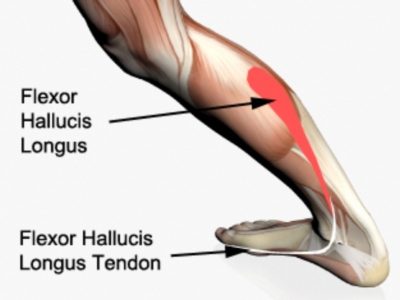
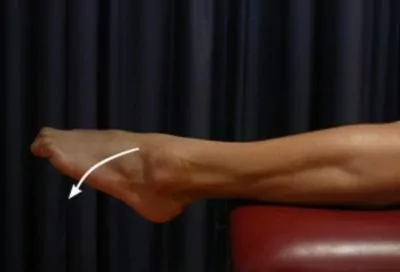
Whenever the flexor hallucis longus muscle contracts or is stretched, tension is placed through the flexor hallucis longus tendon. If this tension is excessive due to too much force or repetition, damage to the flexor hallucis longus tendon may occur. Flexor hallucis longus tendonitis is a condition characterized by damage to the tendon with subsequent degeneration and inflammation.
Causes of flexor hallucis longus tendonitis
Flexor hallucis longus tendonitis may occur traumatically due to a high force going through the tendon beyond what it can withstand or more commonly due to gradual wear and tear associated with overuse. This is particularly common in ballet dancers who spend significant time rising onto their toes.
Signs and symptoms of flexor hallucis longus tendonitis
Patients with this condition typically experience pain in the region of the inner ankle which may travel down into the big toe. In less severe cases, patients may only experience pain with rest following activities requiring strong or repetitive contraction of the flexor hallucis longus muscle such as standing on the balls of the feet, running (especially uphill or on uneven surfaces), jumping, hopping etc. They may also experience pain and stiffness upon waking the following morning. As the condition progresses, patients may also experience pain during these activities affecting performance. The pain associated with this condition tends to be of gradual onset which progressively worsens over weeks to months with continuation of aggravating activities. Patients with this condition may also experience pain on firmly touching the flexor hallucis longus tendon (figure 1).
Diagnosis of flexor hallucis longus tendonitis
A thorough subjective and objective examination from a physiotherapist may be all that is necessary to diagnose flexor hallucis longus tendonitis. An MRI or ultrasound may be required to confirm diagnosis.
Treatment for flexor hallucis longus tendonitis
Most patients with flexor hallucis longus tendonitis heal well with an appropriate physiotherapy program. The success rate of treatment is largely dictated by patient compliance. One of the key components of treatment is that the patient rests sufficiently from any activity that increases their pain until they are symptom free (crutches may be required). This allows the body to begin the healing process in the absence of further tissue damage. Once the patient can perform these activities pain free, a gradual return to these activities is indicated provided there is no increase in symptoms.
Ignoring symptoms or adopting a ‘no pain, no gain’ attitude is likely to lead to the condition becoming chronic. Once chronic, healing slows significantly resulting in markedly increased recovery times and an increased likelihood of future recurrence. Immediate appropriate treatment in all patients with flexor hallucis longus tendonitis is vital to ensure an optimal outcome.
Following the R.I.C.E. Regime particularly with regular icing and anti-inflammatory medication may help to significantly reduce inflammation in the initial phase of this condition. A graduated flexibility, strength and balance program under direction from a physiotherapist is vital to ensure an optimal outcome.
In the final stages of rehabilitation, a gradual return to activity or sports should occur under guidance from the treating practitioner and provided there is no increase in symptoms.
Contributing factors to the development of flexor hallucis longus tendonitis
There are several factors which can predispose patients to developing a flexor hallucis longus tendonitis. These need to be assessed and corrected with direction from the treating physiotherapist and may include:
- poor foot biomechanics (especially flat feet)
- poor flexibility
- inappropriate training or footwear (especially wearing shoes that are too big)
- inadequate warm up
- muscle weakness
- incorrect technique (especially in ballet dancers)
- inadequate rehabilitation following previous injury
Physiotherapy for flexor hallucis longus tendonitis
Physiotherapy treatment is vital to hasten the healing process, ensure an optimal outcome and reduce the likelihood of recurrence in all patients with this condition. Treatment may comprise:
- soft tissue massage
- electrotherapy (e.g. ultrasound)
- anti-inflammatory advice
- stretches
- joint mobilization
- ice or heat treatment
- taping
- the use of heel wedges
- the use of crutches
- exercises to improve strength, flexibility and balance
- education
- activity modification advice
- biomechanical correction
- footwear advice
- a gradual return to activity program
Prognosis of flexor hallucis longus tendonitis
Most patients with this condition heal well with an appropriate physiotherapy program. This, however can be a length process and may take several months in patients who have had their condition for a long period of time. Minor cases of this condition that are identified and treated early can usually settle within a few weeks. Early physiotherapy treatment is vital to hasten recovery and ensure an optimal outcome.
Other intervention for flexor hallucis longus tendonitis
Despite appropriate physiotherapy management, some patients with flexor hallucis longus tendonitis do not improve. When this occurs the treating physiotherapist or doctor can advise on the best course of management. This may involve further investigations such as an X-ray, Ultrasound, CT scan or MRI, pharmaceutical intervention, corticosteroid injection, autologous blood injection, or review by a specialist who can advise on any procedures that may be appropriate to improve the condition. A review with a podiatrist for the prescription of orthotics and appropriate footwear advice may also be indicated.
Exercises for flexor hallucis longus tendonitis
The following exercises are commonly prescribed to patients with this flexor hallucis longus tendonitis. You should discuss the suitability of these exercises with your physiotherapist prior to beginning them. Generally, they should be performed 3 times daily and only provided they do not cause or increase symptoms.
Foot and Ankle Up and Down
Move your foot and ankle up and down as far as possible and comfortable without pain (figure 3). Repeat 10 – 20 times provided there is no increase in symptoms.
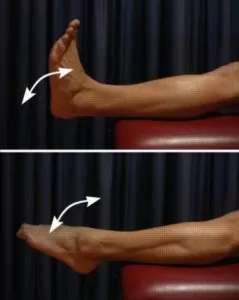
Foot and Ankle In and Out
Move your foot and ankle in and out as far as possible and comfortable without pain (figure 4). Repeat 10 -20 times provided there is no increase in symptoms.
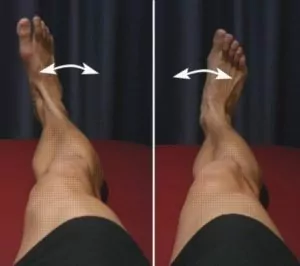
Lunge Stretch
With your hands against the wall, place your leg to be stretched in front of you as demonstrated (figure 5). Keep your heel down. Gently move your knee forward over your toes as far as possible and comfortable without pain. Hold for 5 seconds and repeat 10 times at a mild to moderate stretch provided there is no increase in symptoms.
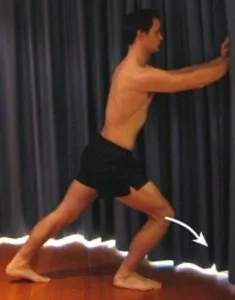
Find a Physio for flexor hallucis longus tendonitis
Find a physiotherapist in your local area who can treat flexor hallucis longus tendonitis.
More information
- View more Ankle Stretches.
- View Ankle Strengthening Exercises.
- View Balance Exercises.
- View our Ankle Diagnosis Guide.
Physiotherapy products for flexor hallucis longus tendonitis
Some of the most commonly recommended products by physiotherapist to hasten healing and speed recovery in patients with flexor hallucis longus tendonitis include:
-
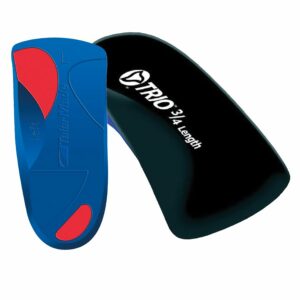 Talar Made TRIO Orthotics (3/4 length)
Talar Made TRIO Orthotics (3/4 length) -
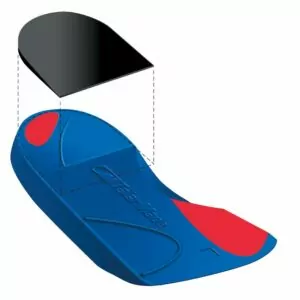 Heel Lifts (Elevators – Talar Made) (Pack of 5 Pairs)
Heel Lifts (Elevators – Talar Made) (Pack of 5 Pairs) -
 Forearm Crutches Adjustable – Standard Grip
Forearm Crutches Adjustable – Standard Grip -
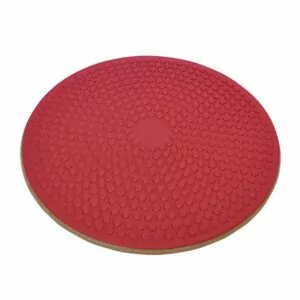 AllCare Wobble Board (Red – ACWOBRD)
AllCare Wobble Board (Red – ACWOBRD) -
 Premium Strapping Tape 38mm (Victor)
Premium Strapping Tape 38mm (Victor) -
 Fixomull Stretch 5cm x 10m
Fixomull Stretch 5cm x 10m -
 AllCare Instant Cold Pack (15 x 25cm)
AllCare Instant Cold Pack (15 x 25cm) -
 Comffit EVA Heel Lifts (Pack of 2 Pairs)
Comffit EVA Heel Lifts (Pack of 2 Pairs)
To purchase physiotherapy products for flexor hallucis longus tendonitis click on one of the above links or visit the PhysioAdvisor Shop.
Become a PhysioAdvisor Member
-
 Individual Membership (12 Months)$59.95 for 1 year
Individual Membership (12 Months)$59.95 for 1 year -
 Individual Membership (3 Months)$39.95 for 3 months
Individual Membership (3 Months)$39.95 for 3 months -
 Individual Membership (Yearly)$49.95 / year
Individual Membership (Yearly)$49.95 / year -
 Individual Membership (Monthly)$15.95 / month
Individual Membership (Monthly)$15.95 / month

Link to this Page
If you would like to link to this article on your website, simply copy the code below and add it to your page:
<a href="https://physioadvisor.com.au/injuries/ankle/flexor-hallucis-longus-tendonitis”>Flexor Hallucis Longus Tendonitis – PhysioAdvisor.com</a><br/>PhysioAdvisor offers detailed physiotherapy information on flexor hallucis longus tendonitis including: causes, symptoms, diagnosis, treatment, exercises, physiotherapy products and more...
Return to the top of Flexor Hallucis Longus Tendonitis.
